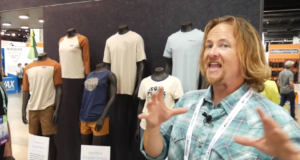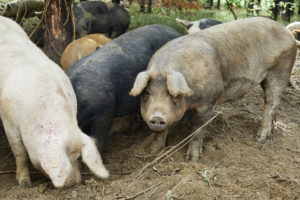Dear ROA Community, As we welcome the warmth and vitality of June and the summer…

Lines in the Soil
As we launch into this next season (summer in the North, winter in the South), one thing is very clear – we are on the cusp of massive transformation on many levels and in many sectors. Over this last month, we’ve connected with leaders from across the spectrum – from the passionate, outdoor activist mindset encountered at Outdoor Retailer Summer Market to major influential agriculture stakeholders of the US Farmers & Ranchers Alliance and the dynamic organizers from the Aspen Institute for the inaugural Harvest Forum. We have a seat at the table, and we are going to continue to encourage them to recognize and reward farmers for regenerative organic practices including the retention of water, preservation of biodiversity, improved soil health, and carbon drawdown. We are encouraged by the broad recognition of the benefits of regenerative practices, echoed by unique initiatives in big ag. We insist they must have real teeth to merit the use of regenerative language.
The undeniable common thread weaving us together is the collective understanding that Earth is in peril. Humans are causing it. And shifting agricultural practices holds tremendous power to sink carbon and change course. It is our charge to hold the high bar. Pioneering brands, innovative farmers, brave policymakers, leaders and dreamers are coming together to bring bold visions of change to fruition.
The long days of summer have arrived in Northern California and our harvest baskets are filled with delicious abundance. We honor the farmers, who are working from dawn to late evening to fill our collective belly. We hope this finds you enjoying the first fruits of summer and that it helps inspire you to continue to activate the Journey to Regenerative Organic.
May your bellies be full,
Elizabeth Whitlow
Executive Director, Regenerative Organic Alliance

Apples, Oranges and Lemons
Discernment between Regenerative and Regenerative Organic
The rapid adoption of regenerative concepts and practices is inspiring hope and promise while gaining broad traction. We welcome all on this journey. That said, within this new landscape of regenerative claims, we need a reality check and a critical eye. We support the incorporation of regenerative practices in every sector and truly applaud these fundamental shifts, but we are also wary of weakening the power of truly regenerative transformations. There is nothing regenerative about chemically-based fertilizers and pesticides linked with GMO monocropping systems. Period. We need to adopt an entirely new model, not inject convenient regenerative concepts into industrial farming – the same exact model that got us here in the first place.
As you already know, high-input, industrialized models of agriculture are decidedly not feeding the world, especially considering that over 76% of the corn goes to biofuelor feedlot animals and that the majority of our soy crops are exported for livestock feed abroad. This system is literally crushing our farmers and rural communities, and not feeding the world. Farm gate prices are at all-time lows, plummeting to levels not seen since the early 2000s, bankruptcies are up, and export markets are fading away. The greatest beneficiaries are giant multi-national agribusinesses and the lobbyists who advocate for them when it should be farmers and farm workers.
Pesticides have wrought havoc on the very ecosystems upon which all living creatures depend. How can we include these in a system called regenerative? Though we so very much appreciate the moves for big ag to move towards regenerative, without the organic foundation, the term “regenerative” risks greenwash. Allowing organic principles and their benefits to slip through the cracks – both environmentally and socially – threatens the regenerative movement as a whole. Please join us in taking a firm hand to ensure that our land, our animals, and our people are protected by the foundation of organic as we build the house of regenerative organic.
Farmers are innovative and adaptive when given the opportunity to explore new pathways. We are seeing very rapid adoption of regenerative practices like composting, cover cropping, diversifying crops, roller crimping and minimal tillage. Carbon draw-down is now a widely known phenomenon, seemingly on the tip of everyone’s tongue. Though all of this is wonderful and feels like progress, we know that when these practices are activated on the foundation of organic, our rewards are not only greater, but the security of healthy soil, animals and farm workers is strengthened.
Regenerative Organic Certified is wedded to organic principles. Our founders, allies, and farmers believe in the potential of agriculture to create solutions to the climate crisis and build a more sustainable, healthy, and secure food system. Organic is the foundation of this program.

See Patagonia’s sales mavens discuss their ROC cotton program here.
Radical Disrupters
When we think of agriculture, we must remember it’s not only food that is born of the soil. It is also fiber, leather, and rubber that forms the basis of our clothing and outdoor gear. Outdoor Retailer Summer Market is a tradeshow. It’s where buyers, customers, and industry leaders gather to discuss the intersection of land, sea, and sky- all the places where we play, create and imagine. We are encouraged that the design teams who make the gear that we use to enjoy and challenge our relationship with Earth possess a great understanding of greening supply chains. Many kudos to standout companies such as Patagonia, Adidas, and Saltwater Brewery that are leading and collaborating in the effort.
Many themes at this show resonated with us, but what especially stood out was the very dynamic demographic that attends Outdoor Retailers. It is stacked with true disruptors. Real life, eco-warrior Doug Peacock (the basis for Ed Abbey’s legendary protagonist Hayduke from the Monkey Wrench Gang) set the tone with his keynote advocating the case for civil disobedience in times of need and especially, in the preservation of the wild. Peacock’s comment about what gives him a sense of hope is “the hearts and minds of some really good human beings…who care about their communities and care beyond their own species.” What is apparent is that the OR audience is more and more willing to radically look at business-as-usual and follow through with fundamental changes in practice.
One shining example of this is Outdoor Retailers’ stance on waste. No single-use plastic is allowed at the conference. This is a high bar for all eco-minded conferences, and frankly highlighting the irony of other such conferences where you can’t recycle anything, and where no thought is given to the amount of plastic trash generated some food and product samples. With this simple effort, Outdoor Retailers is defying the status quo of these industry events, and setting the new standard. We expect that others will soon follow suit.
Our Patagonia-hosted event on the second day of OR was a two-part panel, led by Lewis Perkins of the Apparel Impact Institute and Elizabeth Whitlow, the ROA’s executive director, to expand the conversation of the ROC with a panel on supply chains and regenerative organic agriculture. The role that the ROC plays in this is keen- as we continue to roll out, we will be able to openly share ROC certified supplies with those who can and will integrate them into their supply chains. The take-aways were enthusiastic and productive:
The ROC panel was such a unique conversation at Outdoor Retailer as brands from multiple sectors spanning apparel, food, and personal care products shared their perspectives on regenerative agriculture and how collaboration across brands and industries can drive this work forward rapidly and efficiently.
I’m incredibly excited about Timberland’s ongoing work to develop regenerative supply chains for leather, cotton, and rubber and look forward to exploring additional opportunities for us to collaborate with pioneering brands in this space. For example, could Timberland work with Dr. Bronner’s to support regenerative palm oil and eventually use it in our bio-based outsoles? This is a really exciting proposition that wasn’t on our radar prior to this session and I can’t wait to dig into it further.”
– Zachary Angelini, Manager – Environmental Stewardship, Timberland

There were endless romantic and pragmatic reflections generated from and at OR. Here are a few others to check out:
- Patagonia and Dr. Bronner’s hosted another panel in “Venture Out,” an area dedicated to B Corps, new start-ups, and all manner of ecologically minded companies. Organized by infinitely beautiful Range, we heard from David Bronner and Birgit Cameron on a panel called Impact Friendly Adventure.
- Patagonia celebrating all things ROC and promoting the upcoming ROC cotton collection
- Adidas’ partnership with Parley to transform plastic waste removed from oceans into shoes
- Saltwater Brewery’s video announcing the debut of edible beer can rings. In their words, “Beer is a good vessel…it gets people to listen.”

ROC Pilot Update
The function of the ROC Pilot is to put the entire standard into practice. This is a celebration of the hard work of multiple entities from the certifiers, the auditors, NSF, producer representatives. Moreso, this is a celebration of all the hard work of farmers across the globe – from family farmers to smallholders to grower groups, representing commodities that have the power to shift supply chains.
Of recent successful developments including onboarding more certification bodies, and scheduling summer audits, most notable is the formation of Social Task Force and Animal Welfare Task Force. Both had their first meetings this week. Each group is balanced, comprised of experts in their fields, all stakeholders working collaboratively under the guidance of an impartial Chair. The structure and process we have built will provide transparency and credibility to support the success and integrity of the ROC program.
These task forces will work in two phases. The first is to create a list of potential deviations needed from the framework because the specific criteria point may be a potentially insurmountable barrier. The second phase will be conducted after the pilots are completed so that recommendations can be made for the ROA board and a comprehensive update to the ROC framework can be made.
Pigs and Weathering the Storm
Corinne Kocher / words
Bailey Garrot / images
Bailey Garrot / images
“Well, just look at a pig’s face,” instructs Kylan Hoover, swine manager at White Oak Pastures. We’re standing next to the fence lining the border forest, watching the herd of pigs that had come running over at Kylan’s confident approach. He’s got one foot propped up on the fence, his hands gesturing toward the pigs crowding around.”See how there’s a flat disc up front, their nose? Think about their face as a shovel. The top of the disc is the cutting edge, the disc is the bottom side of the shovel.”
Kylan starts to mimic a shovel with his hands. “When pigs root, looking for food, they do a scooping movement.” He sighs and drops his arms. “Do you see it? A pig’s basic movement is tilling the soil.”

Kylan is part of the management team at White Oak Pastures, an operation known for practicing and advocating holistic, regenerative land management practices. “Regenerative agriculture” is no simple thing – keeping the life in the soil intact requires a lot of moving parts. In a regenerative pasture system, you’re trying to build a diverse ecosystem of different kinds of perennial polycultures. You’re wanting resilient, established root systems in the ground. You’re working to sequester carbon in the organic matter in the soil, keeping the nutrients and minerals you already have in the ground as well. All of this usually means… avoiding tillage.
“It’s tricky to use pigs instead of cows in your regenerative rotation, because pigs are a destructive event.” Kylan looks back at the pigs. “So we’re out here trying to regenerate the soil, keep the tilth, the bacteria, mycelium, etc intact – and if pigs were on the pasture, they would turn over the soil and bake it in the sun.”

White Oak Pastures is usually associated with cattle. Will Harris III had inherited a conventional commodity cattle operation. During Will’s return toward holistic, “radically traditional” agriculture over the last 20 years, cattle remained the backbone of the operation. But that growth toward regenerative practices also grew the number of species living on the farm. Today, over 10 species make up a verifiable ecosystem of different kinds of animal impact – including herds of pigs.
But while feral pigs roam all over south Georgia (and an individual hog can cause an enormous amount of destruction by itself), domestic pigs can cause an even bigger impact when concentrated in herds. So most people ask: where do you put a herd of pigs, to limit their damage?
For Kylan, and White Oak Pastures, it’s not always a question of limiting the destruction that pigs can do – it’s asking, “where can their intense damage be helpful?” Because pigs, in their role as system disruptors, may actually reveal the strong relationship between soil regeneration and ecological – and community – resiliency.
This is the 3rd installment of Bailey and Corinne’s investigative and narrative storytelling will continue,
a special feature we are proud to support. You can catch the ones you missed on their website, Shared Plates.
